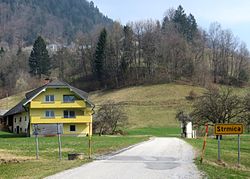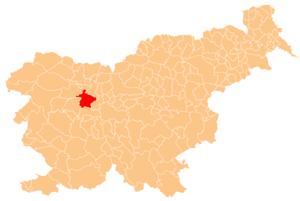
Slovene or Slovenian belongs to the group of South Slavic languages. It is spoken by approximately 2.5 million speakers worldwide, the majority of whom live in Slovenia. It is the first language of about 2.1 million Slovenian people and is one of the 24 official and working languages of the European Union.
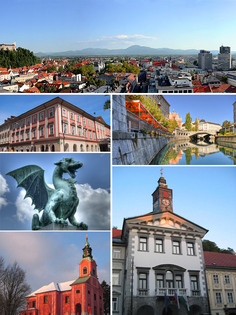
Ljubljana is the capital and largest city of Slovenia. It has been the cultural, educational, economic, political, and administrative centre of independent Slovenia since 1991.

The Slovenia national football team represents Slovenia in international football and is controlled by the Football Association of Slovenia. In the period between 1920 and 1991, Slovenia was ineligible to field a separate team for competitive matches; local players instead played for the Yugoslavia national football team. Slovenia played its first official match in 1992, one year after the country gained independence from Yugoslavia.

Logatec is a town in Slovenia. It is the seat of the Municipality of Logatec. It is located roughly in the centre of Inner Carniola, between the capital Ljubljana and Postojna. The town of Logatec has seen rapid industrial development and immigration since the completion of the nearby A1 motorway to the coast.
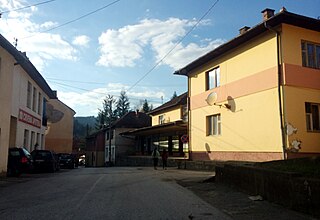
Rudo is a town and municipality located in Republika Srpska, an entity of Bosnia and Herzegovina. As of 2013, it has a population of 7,963 inhabitants.
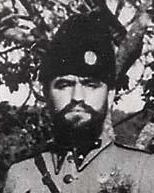
Momčilo Đujić was a Serbian Orthodox priest and Chetnik commander who led a significant proportion of the Chetniks within the northern Dalmatia and western Bosnia regions of the Independent State of Croatia during World War II. After the assassination of King Alexander of Yugoslavia in 1934, he joined the Chetnik Association of Kosta Pećanac. After the invasion of Yugoslavia, he defended local Serbs against the Croatian fascist Ustaše regime and collaborated with the Axis powers against the Communist-led Yugoslav Partisans throughout the remainder of the war as the commander of the Chetnik Dinara Division. He survived the war, surrendering to the western Allies and eventually emigrating to the United States. He was tried and convicted in absentia for war crimes by the Yugoslav government, including collaboration and responsibility for the deaths of 1,500 people during the war.
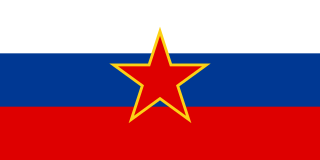
The Socialist Republic of Slovenia was one of the six republics forming the post-World War II country of Yugoslavia. It existed under different names from 29 November 1945 until 25 June 1991. In 1990, while the country was still a part of the Yugoslav federation, the League of Communists of Slovenia allowed for the establishment of other political parties, which led to the democratization of the country. The official name of the republic was Federal Slovenia until 20 February 1946, when it was renamed the People's Republic of Slovenia. It retained this name until 9 April 1963, when its name was changed again, this time to Socialist Republic of Slovenia. On 8 March 1990, the Socialist Republic of Slovenia removed the prefix "Socialist" from its name, becoming the Republic of Slovenia, though remaining a constituent state of the Socialist Federal Republic of Yugoslavia until 25 June 1991, when it enacted the laws resulting in independence.

Strmica is a small village in the Knin Municipality. It is located north of Knin, just south of the border to Bosnia & Herzegovina. The population is 268.

Strmec is a small dispersed settlement in the hills south of Črni Vrh in the Municipality of Idrija in the traditional Littoral region of Slovenia.

Strmca is a small village west of Planina in the Municipality of Postojna in the Inner Carniola region of Slovenia.

Strmica is a small settlement in the hills west of Vrhnika in the Inner Carniola region of Slovenia.

The statistical regions of Slovenia are 12 administrative entities created in 2000 for legal and statistical purposes.

D33 connects Šibenik to Drniš and Knin. Furthermore, the road has junctions to major state roads, namely D8 in Šibenik, connecting to Biograd na Moru and Trogir, and D1 state road in Knin, which in turn connects to Sinj to the south and to Gračac to the north. The southern terminus of the road is found in Vidici interchange near Šibenik. The road is also connected to A1 motorway in Šibenik interchange. The road is 73.3 km (45.5 mi) long. The northern terminus of the road is at Strmica border crossing to Bosnia and Herzegovina, where the road proceeds to Drvar.

Velika Strmica is a small settlement in the Municipality of Mokronog-Trebelno in southeastern Slovenia. The area is part of the historical region of Lower Carniola. The municipality is now included in the Southeast Slovenia Statistical Region.

Mala Strmica is a settlement in the Municipality of Šmarješke Toplice in southeastern Slovenia. It lies in the hills northwest of Šmarjeta in the historical region of Lower Carniola. The municipality is now included in the Southeast Slovenia Statistical Region.

The Dinara Division was a Chetnik division that existed during World War II. Organized in 1942 with assistance from Ilija Trifunović-Birčanin and headed by Momčilo Đujić, the division incorporated commanders in Bosnia and Herzegovina, northern Dalmatia, and the Lika region with the intent of establishing a purely Serb state cleansed of other nationalities. The division was under the control of supreme Chetnik commander Draža Mihailović and received aid from Dimitrije Ljotić, leader of the Serbian Volunteer Corps, and Milan Nedić, head of the Serbian puppet Government of National Salvation.

Podutik is a former settlement in central Slovenia in the northwest part of the capital Ljubljana. It belongs to the Dravlje District of the City Municipality of Ljubljana. It was part of the traditional region of Upper Carniola and is now included with the rest of the municipality in the Central Slovenia Statistical Region.
